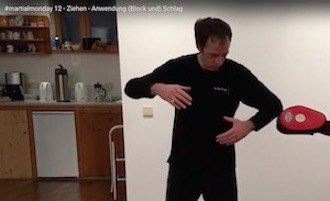#martialmonday 12 – I’m stuck! v. I’m off then. The point of attention in pulling – application (block and) punch
This week we start from another practical application of the movement pull: both hands punch.
The exercise

For the exercise, we need to build fists instead of the open hands in the form. In the beginning, the direction of the rotation – the „orbit“ – of the hands should be like in the form: slightly tilted (diagonally downwards). This makes the connection to the foot much easier. Later, you may try to vary.
One Posture – many possibilities
One commonly known phrase says: Every posture of the form has countless applications. What does that mean?
Concerning the pull, these are:
- A punch with the left hand

- A punch with the right hand
- Pulling to the left
- Pulling to the right
And – as we saw last week:
- Neutralising slowly
- Escaping quickly
Fair enough. But that does only add up to four or six!?
If you grow into the shape, all points between starting point and shape are suitable hitting points. Where you hit the Other – and if so with which hand – does not matter.
Okay, so that means a fantastic amount of possibilities – or doesn’t it?
Many possibilities – one intention
If you take the situation of pulling with your back against the wall as an example (see #martialmonday11), there is often one problem with the exercise: One tends to fix one’s attention to the contact point. Your partner is pushing like crazy. And you try to quickly drag your arm away – wanting to free yourself. Your attention stays, where your partner is pushing. – It is determined, and ultimately also controlled, by him. Such an attempt to escape will fail inevitably.
The solution for your dilemma is to stick with your shape. In this case: Just punch with the back of your fist. Your arm will follow. Due to this mental change of attention, your partner will have trouble to read your movement and to follow.
The way to practise
The changing of intention is an aspect, which can be (and has to be) practised separately. At the beginning, you have to take care to practise with only a little pressure – otherwise, you will blight any opportunity to learn. Later, more and more pressure may be applied. If we have mastered the principle of changing in its basic strokes, we may work further on speed and intensity of the change.






